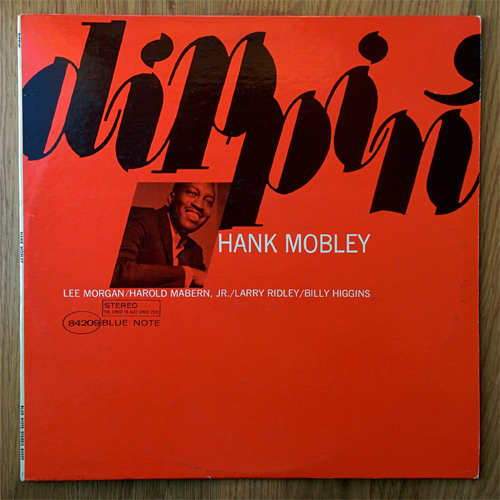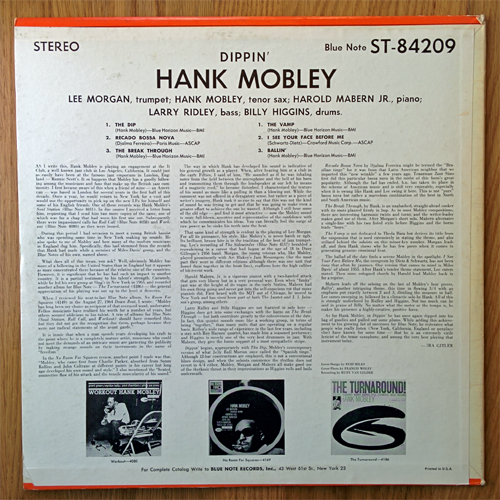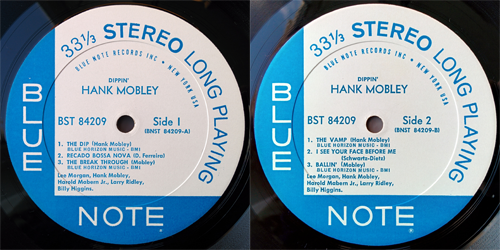
Discographical Details
Artist: Hank Mobley.
Title: Dippin’.
Label and Catalogue Number: Blue Note BNST 84209.
Personnel: Lee Morgan (trumpet); Hank Mobley (tenor sax); Harold Mabern Jr (piano); Larry Ridley (bass); Billy Higgins (drums).
Side 1: The Dip; Recado Bossa Nova; The Break Through.
Side 2: The Vamp; I See Your Face Before Me; Ballin’.
Recording Date: 18 June 1965 at the Rudy Van Gelder Studio, Englewood Cliffs, New Jersey, USA.
Listening Notes

I’ve made several attempts to write this posting over the last week or two and each time I’ve given up, dissatisfied with the direction things were going. Finally, last Sunday afternoon, I worked out why an apparently straightforward task was giving me so much difficulty. You see, it parallels the record itself: on the face of things Dippin’ looks and sounds like an archetypal Blue Note 1960’s recording – indeed, almost a model, if unsung, one. But on deeper thought, I realised that this is a transitional record. Transitional for Mobley, transitional for Blue Note and therefore transitional for collectors. And that’s what makes it harder to write about.
Mobley’s career and sound up to 1960 followed a consistent trajectory. Then came the two great records of that year, Soul Station and Roll Call, and the short-lived tenure with Miles Davis before Mobley returned to leading his own line-ups. After recording Workout, Mobley’s sessions with Blue Note went through an odd period with some not being released at the time (e.g. Another Workout and Straight No Filter) and others being paired together to compile records like The Turnaround! and No Room For Squares. For me, Dippin’ marks the culmination of this transition and the emergence of a more confident, consistent and richer sounding Mobley.
For Blue Note, too, this was a period of transition. The Dippin’ session was recorded on 18 June 1965, while Blue Note was still an independent record label. But by the time of the record’s release, the company had been sold to Liberty and change was creeping in. The result is also transition for collectors, because Dippin’ is one of those “on the cusp” records late enough to pressed at Liberty’s preferred pressing plant (so not the revered Plastylite) but early enough for first pressings to bear left-over New York labels. It was certainly a case of “waste not, want not” in the financially restricted world of jazz recording!
Despite all this, the record itself is a masterpiece of high quality consistency. I suspect one of the key factors in it coming together is the presence of Lee Morgan. Mobley and Morgan were regular complementary sparring partners on each others’ records and Dippin’ is a fine example of the pairing. Morgan is typically ebullient, brash and triumphant on the up-tempo cuts. Never more so that during his solo in the middle of Recado Bossa Nova which starts innocently enough but climaxes with Morgan piling on one sparkling phrase after another. I also like how Mabern shows a genuine feel for latin tunes and some of his comping would not have been out of place on a Fania Records salsa session! Mabern didn’t make much of a splash as a leader his own own right during the 1960s (just a few LPs with Prestige) but was often one of Morgan’s preferred sidemen and he certainly seemed to understand what both Morgan and Mobley wanted underneath them.
The whole of Side 1 is practically a manifesto for the Blue Note sound. An exciting, highly skilled collision of vintage hard bop playing welded to latin themes for The Dip and Recado Bossa Nova with Billy Higgins sustaining the pulse underneath by adding just enough accents for you to enjoy but no so many that they become an intrusion. A smile always comes to my face as the last cut on the side, The Break Through, draws to a close with Higgins trading fours with each of the horn players turn and turn about.
Side 2 is more straight ahead and perhaps not quite so enjoyable but it does offer us the date’s sole ballad I See Your Face Before Me sandwiched between two upbeat Mobley compositions. Mobley brings a mature masculinity to the ballad which is complemented by Morgan’s muted Davis-like tone. The Vamp could easily have been from the soundtrack to a vintage Michael Caine spy thriller and Ballin’ rounds out the set with another sprightly hard bopper.
For Collectors Only

Side 1 is non-deep groove, bears a “VAN GELDER” stamp and has a hand etched matrix number “BNST 84209 A” with a New York label. Side 2 is non-deep groove, bears a “VAN GELDER” stamp and has a hand etched matrix number “BNST 84209 B” with a New York label. The cover is non-laminated and has the “43 West 63rd St., New York 23” address. The vinyl itself weighs in at a chunky 164g.
In this case, being a Liberty pressing, the absence of the Plastylite “P” is to be expected, and the presence of New York labels combined with the weight suggest this is a first pressing. I got this one from a seller in Germany who I admire for the detail and accuracy of his eBay descriptions. He billed the vinyl spot on as “S.1: ex to ex- (some light scratches, some ticks). S.2: ex+ to ex (few light marks+ticks). WONDERFUL SOUND !” – definitely one for my trusted sellers list!

By the time he worked on this album, Hank Mobley had been recording for over ten years and had led over twenty sessions. One approach would be to listen to everything and try to place this in context as: typical / untypical; radical / conventional or dashed off / rehearsed etc. That’s probably a bit too much little trying to write as a musicologist for most of us who want to say something about an artist or one of their albums. Allmusic and Wikipedia can have that territory as far as I’m concerned.
Well done for persevering and finding your own way to tell us about this set. You’ve provided enough context and your insight about this as an album from a transitional period is important. You’ve also responded to the music as you hear it and that is great too.
Looking forward to your next post.
LikeLike
Excellent record, and I agree with your assessment of it signaling the emergence of a more confident Mobley. In my opinion, the two records that followed it, “A Caddy For Daddy” and “A Slice Of The Top” are two of his late masterworks (why “Slice” was never released at the time is beyond me).
LikeLike
Yes, and I’d add “Hi Voltage” to that list of top quality late Mobleys.
LikeLike
Man, I always forget about “Hi Voltage” which is odd since it’s one of the first Mobley titles (and vintage Blue Note LPs by anyone) that I ever scored back in the day. Such a great record! I think I’ll throw it on the turntable tonight!!
LikeLike
Wow, that copy is gorgeous…very nice!
LikeLike
Get some needle drops going so I can listen while I read! 😉
LikeLike
I wondered how long it would be before somebody mentioned adding needle drops. It’s on my radar but I need to sort out the necessary hardware and work out how to reduce the distance between computer and turntable. Watch this space!
LikeLiked by 1 person
Same here. My son has a very inexpensive analogue to digital converter. The results are inconsistent and generally poor. I would think spending a few hundred on an ADC would be the minimum to get some quality sound.
LikeLike